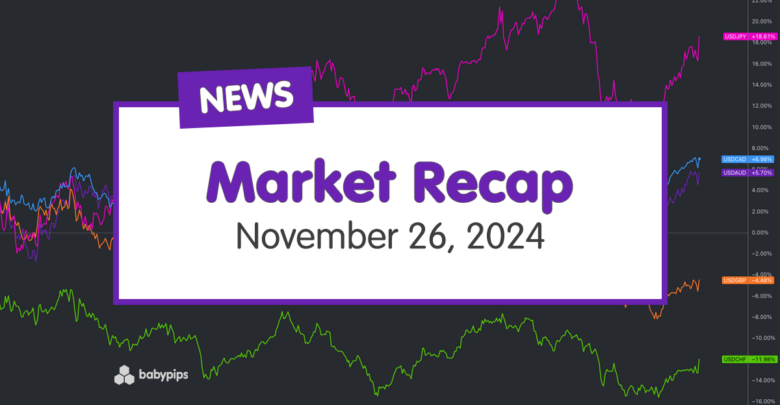
It was truly a busy session as traders showed mixed reactions to Trump’s tariff threats, economic data releases, and very positive geopolitical developments.
What were the key drivers moving financial markets today? Let’s dive into the latest updates!
Headlines:
- US President Trump threatens more tariffs on Canada, China and Mexico
- Russia reportedly gearing up for cyber war against the U.K. and other allies
- Chair of NATO’s Military Committee says business should prepare for a “Wartime Scenario”
- Speaking at the Economic Affairs Committee from the House of Lords, BOE Chief Economist Huw Pill still sees a tight labor market but it has loosened over the past year
- Mexican President Claudia Sheinbaum said she would impose retaliatory tariffs in response to Trump’s plan
- U.S. CB Consumer Confidence read for November 2024: 111.7 (110.0 forecast; 109.6 previous)
- U.S. new home sales data for October 2024: -17.3% (-3.6% m/m forecast; 4.1% m/m previous)
- FOMC Meeting Minutes: officials prefer a careful approach to future interest-rate cuts
- On Tuesday, Deputy BOC Governor Rhys Mendes said it’s reasonable to expect more cuts but they will be data dependent
Prime Minister Justin Trudeau said Canada is prepared to work with the new U.S. administration in “constructive ways” - U.S. President Biden announced on Tuesday that the Prime Ministers of Lebanon and Israel accepted the United States’ proposal to end the devastating conflict between Israel and Hezbollah.
Broad Market Price Action:

Dollar Index, Gold, S&P 500, Oil, U.S. 10-yr Yield, Bitcoin Overlay Chart by TradingView
Early Asian trading was marked by heightened volatility following Trump’s tariff announcement, which appeared to have triggered a mostly brief risk-off response across markets. The U.S. dollar initially strengthened while bonds experienced some turbulence, though these moves faded as markets digested the news heading into the London session.
European hours saw relatively subdued trading conditions, characterized by continued gradual dollar weakness and declining bond yields. This environment may have provided modest support to other financial assets, or it’s possible we were seeing some profit taking repositioning ahead of a busy U.S. calendar. While there were no major events of note, we did get several ECB officials offered commentary during this period, including Centeno and de Guindos, their remarks appeared to have limited market impact.
The U.S. session brought increased activity around economic data releases, with the stronger-than-expected consumer confidence reading potentially offsetting disappointing housing data and a Richmond Fed manufacturing survey.
The 5-year U.S. Treasury Note auction showed robust demand with a bid-to-cover ratio of 2.43 versus the 2.37 six-month average, possibly reflecting sustained appetite for U.S. government debt and bringing a little bit of bullish dollar vibes from that corner of the market.
Then came the latest FOMC minutes release, which generated little market reaction, likely suggesting the cautious approach to policy easing was largely priced in.
This was followed by U.S. President Biden’s announcement of an Israel-Hezbollah peace deal, which appeared to have prompt some modest oil price declines as the threats of a wider regional war fades further with this new agreement.
FX Market Behavior – U.S. Dollar vs. Majors:

Overlay of USD vs. Major Currencies Chart by TradingView
The U.S. dollar was moderately higher on Tuesday, driven early by Trump’s announcement of potential tariffs for Mexico and Canada during the Asia trading session—an attempt to provoke both countries to take action against illegal drugs and immigration into the United States.
The U.S. dollar nearly fully reversed its gains through the rest of Asia and through the London session. With no major catalyst to point to, this was likely due to profit-taking ahead of a busy U.S. calendar that included FOMC meeting minutes and U.S. consumer confidence data.
During the U.S. session, volatility picked up for the U.S. dollar against major currencies surrounding the latest U.S. housing data and the Conference Board’s latest consumer confidence reading. Housing data came in largely as expected, while consumer confidence numbers came in above expectations. The U.S. dollar rallied surrounding the data releases, but it’s also possible that some of the bullish dollar demand may have come from a successful U.S. Treasury auction that showed better than expected demand for the 5-year note.
Later, the FOMC meeting minutes showed that once again members are reluctant to be aggressive with rate cuts given the stability of the U.S. economy and some signs of inflation stickiness. There were no new insights in the meeting minutes, so it’s no surprise that the reaction to the event was relatively muted.
Finally, the U.S. President announced a ceasefire agreement between Israel and Hezbollah, where we saw some weakness in the U.S. dollar following the announcement, likely a signal that some geopolitical fears and wider war expectations were being priced out of the market.
Upcoming Potential Catalysts on the Economic Calendar:
- Australia Construction Work Done QoQ at 00:30 GMT
- Australia CPI at 00:30 GMT
- New Zealand RBNZ Interest Rate Decision at 01:00 GMT
- New Zealand RBNZ Press Conference at 02:00 GMT
- Germany GfK Consumer Confidence at 09:30 GMT
- France Unemployment Benefit Claims at 11:00 GMT
- U.S. Core Durable Goods Orders at 13:30 GMT
- U.S. Durable Goods Orders at 13:30 GMT
- U.S. Goods Trade Balance Adv at 13:30 GMT
- U.S. Wholesale Inventories MoM Adv at 13:30 GMT
- U.S. GDP Price Index QoQ 2nd Est at 13:30 GMT
- U.S. Retail Inventories Ex Autos MoM Adv at 13:30 GMT
- U.S. GDP Growth Rate QoQ 2nd Est at 13:30 GMT
- U.S. Core PCE Price Index MoM at 13:30 GMT
- U.S. Personal Spending MoM at 13:30 GMT
- U.S. Personal Income at 13:30 GMT
- U.S. Initial Jobless Claims at 13:30 GMT
- U.S. Chicago PMI at 14:45 GMT
- U.S. Pending Home Sales MoM at 15:00 GMT
- U.S. EIA Crude Oil Stocks Change at 15:30 GMT
The Asia session is Likely to be busier than usual with top tier events from Australia and New Zealand. The party will start with Australia’s October CPI update, expecting to tick up to 2.3% from 2.1% annually – which could give the RBA more reason to maintain their less dovish stance.
Next we’ll get the latest monetary policy statement from the Reserve Bank of New Zealand (RBNZ), which is expected to continue its rate-cutting journey with another hefty 50 basis point reduction, taking their Official Cash Rate to 4.25%.
The U.S. schedule is packed to the brim with economic updates because of the upcoming U.S. holiday, but the most likely market movers will be the preliminary GDP report and the core PCE price index report.
The GDP report will be a second look at the U.S. economic growth rate of the third quarter of 2024, and if there is a large divergence between the advanced read and the preliminary read, then there could be a large pick up in volatility in the U.S. dollar.
This will be followed by the Fed’s preferred inflation gauge – the core PCE price index rate of change, which is expected to maintain its monthly pace of 0.3%, with the annual rate holding steady at 2.7%. A persistent above-target inflation read could keep the Fed cautious about aggressive rate cuts ahead.
Make sure you’re glued to the tube in case we see increased volatility during their events, and don’t forget to check out our Currency Correlation tool when taking any trades!


